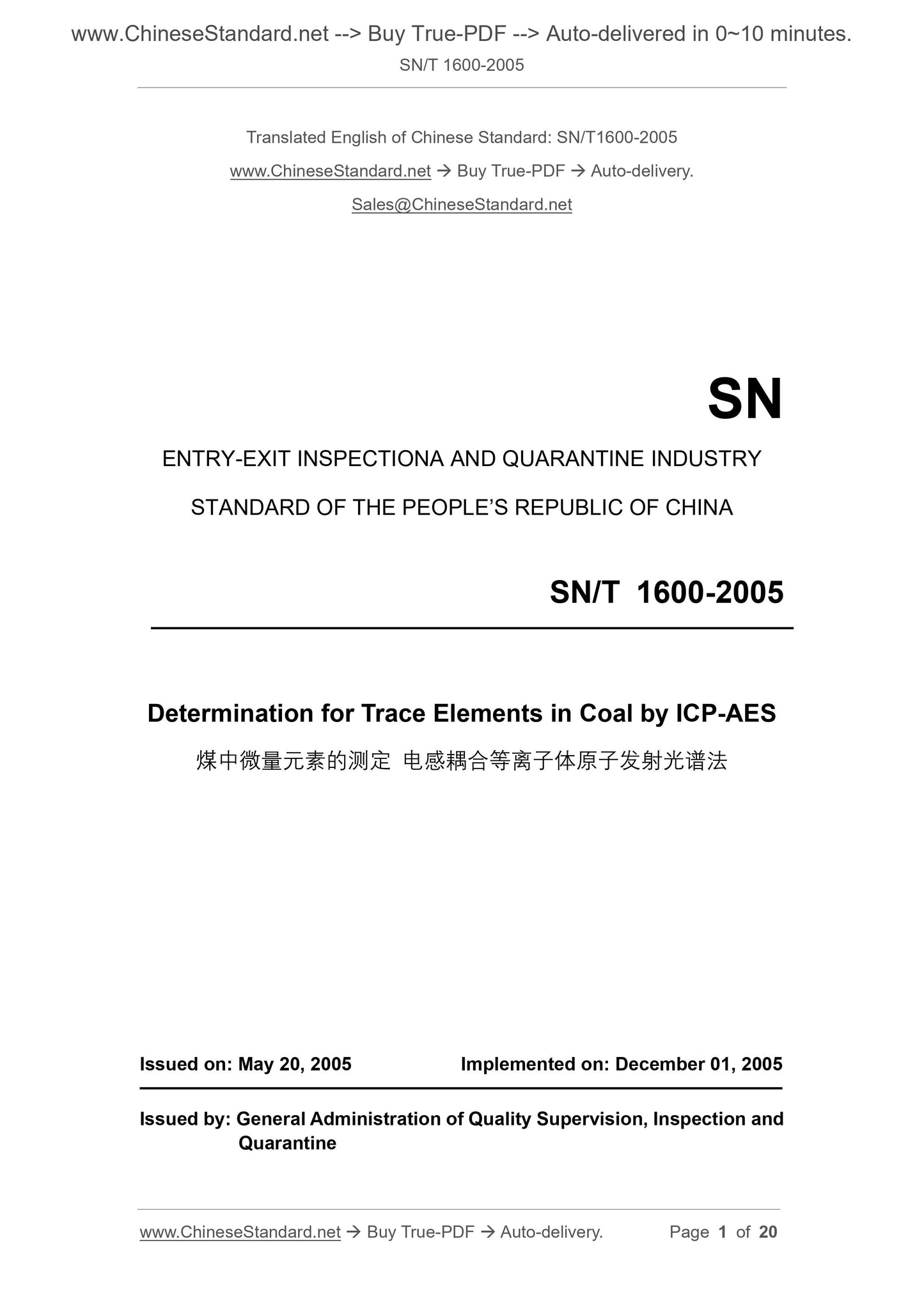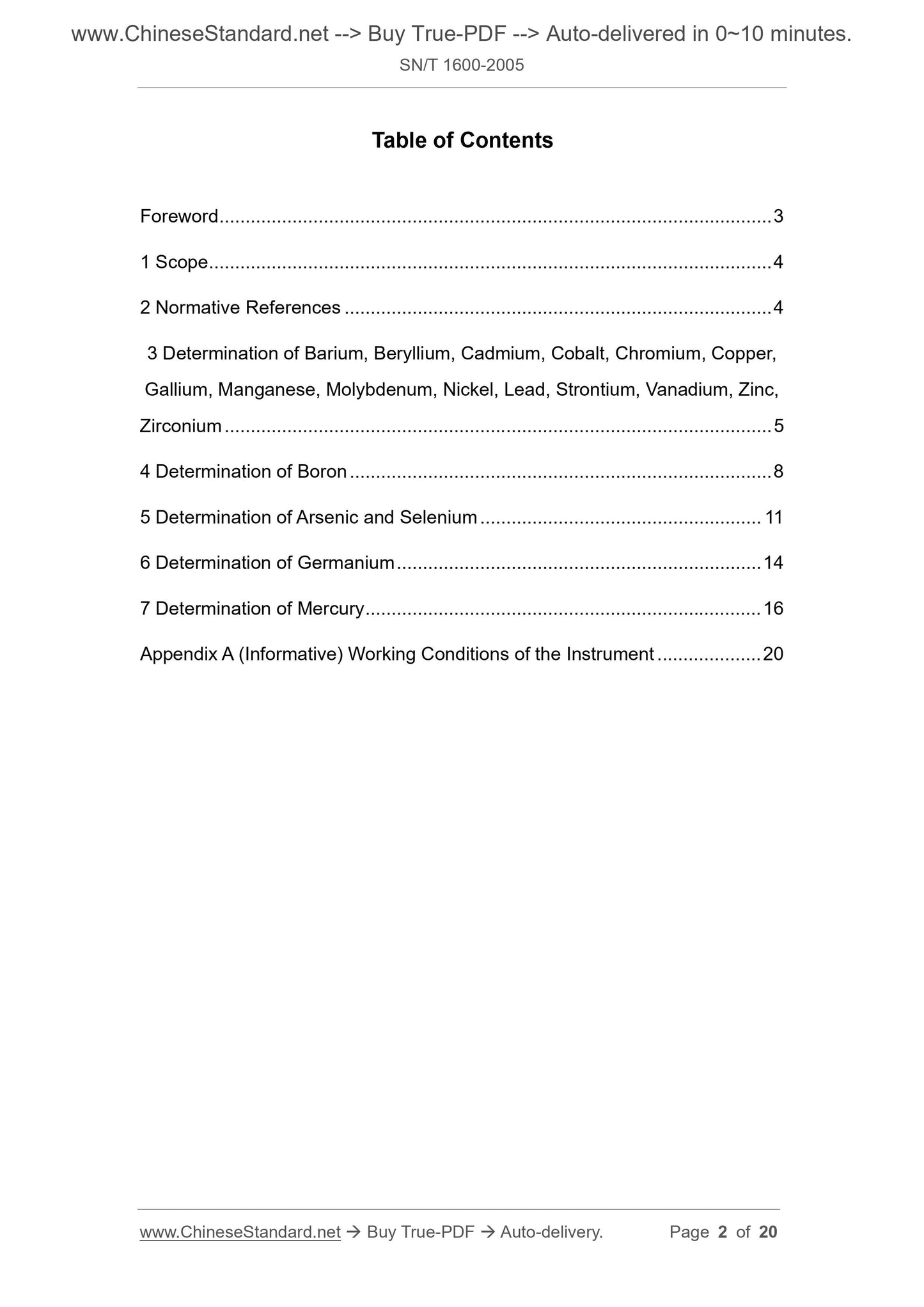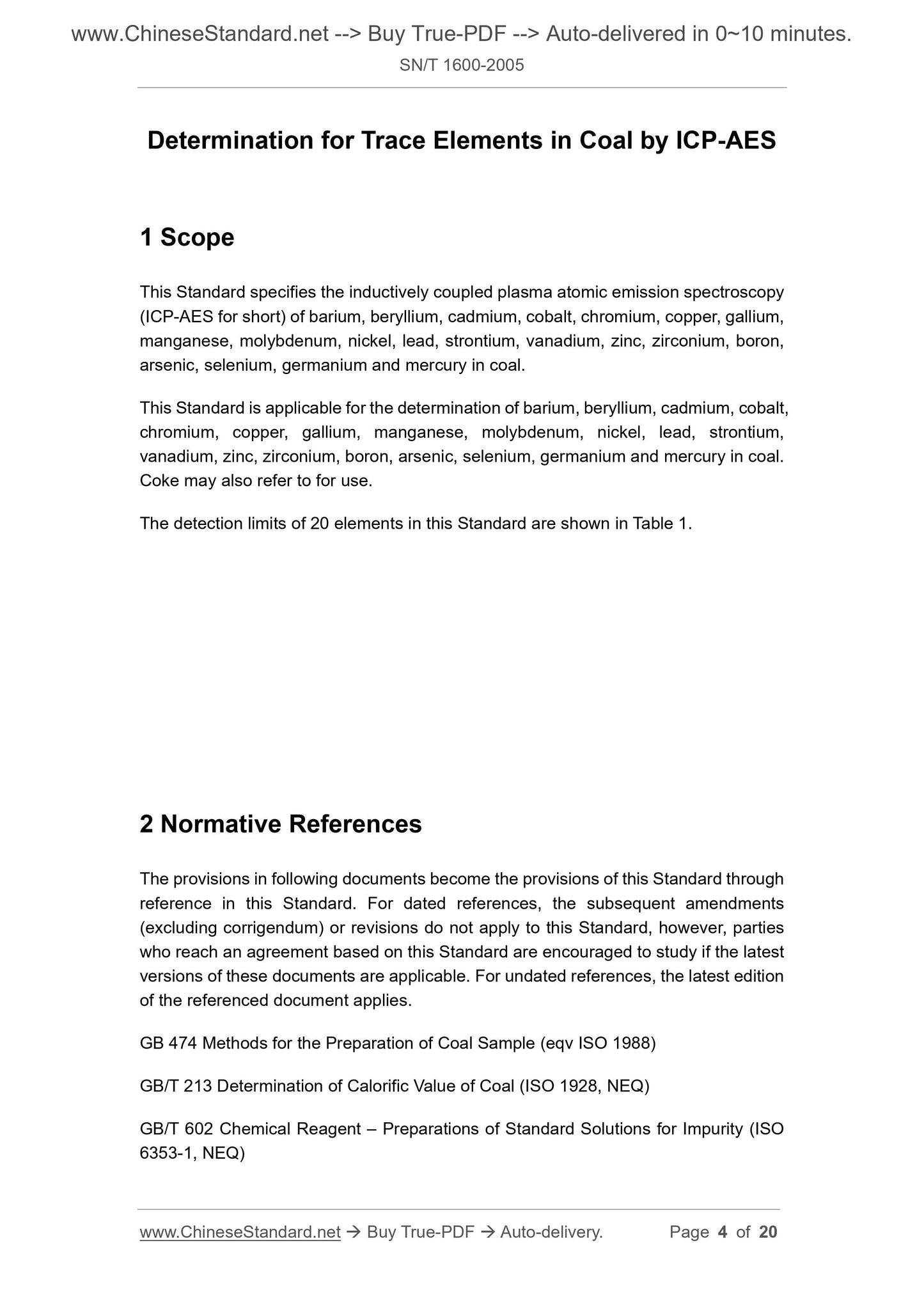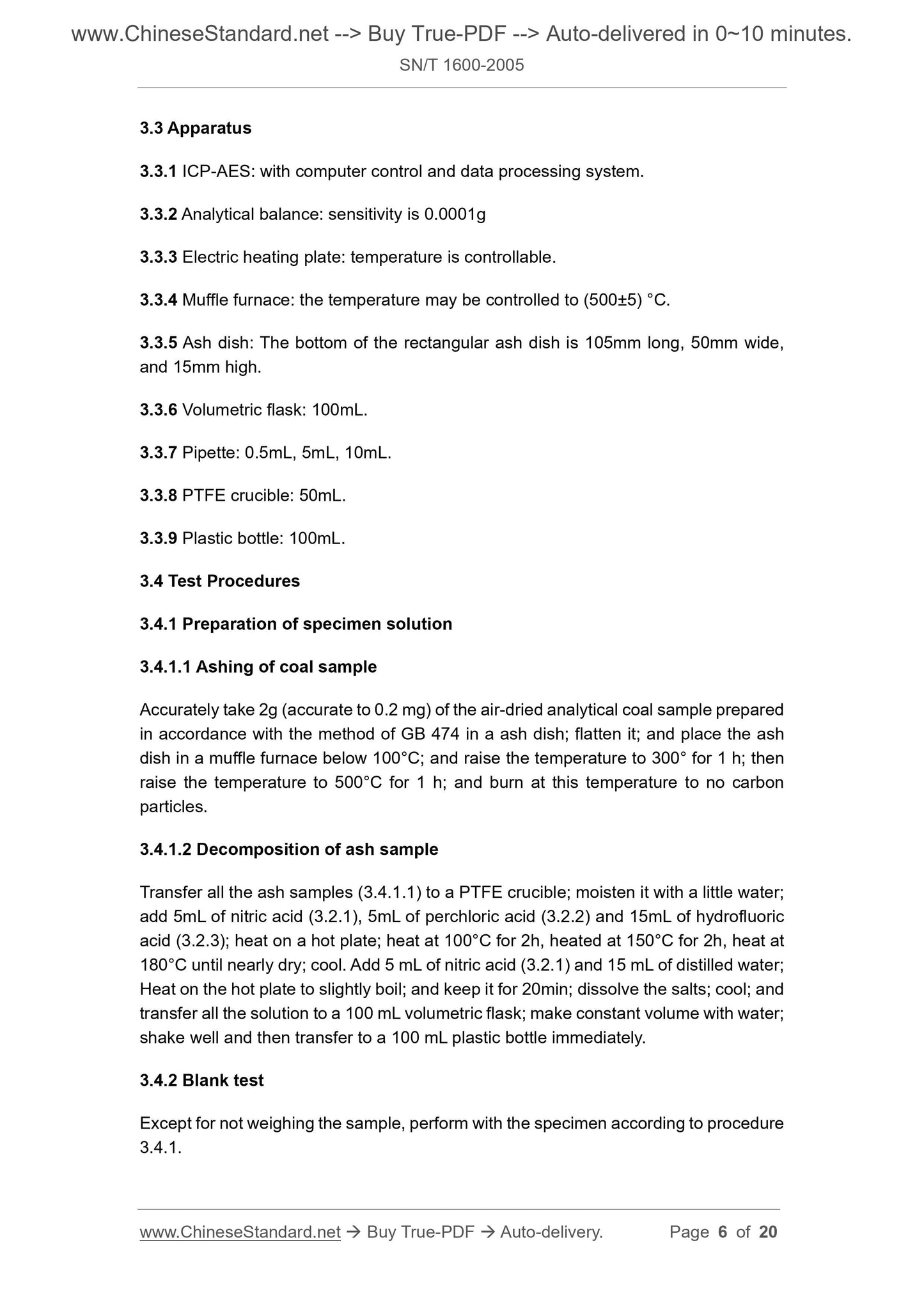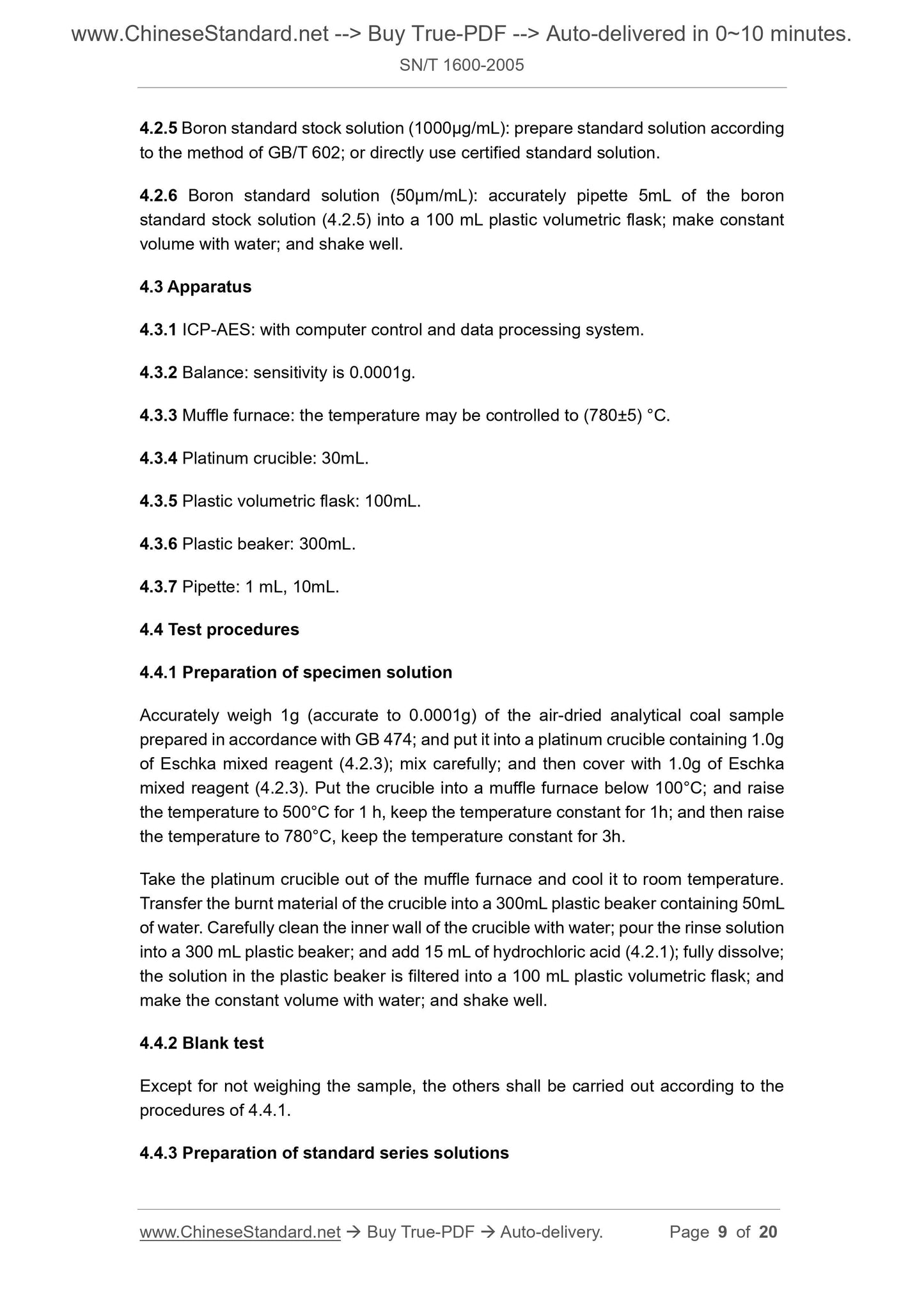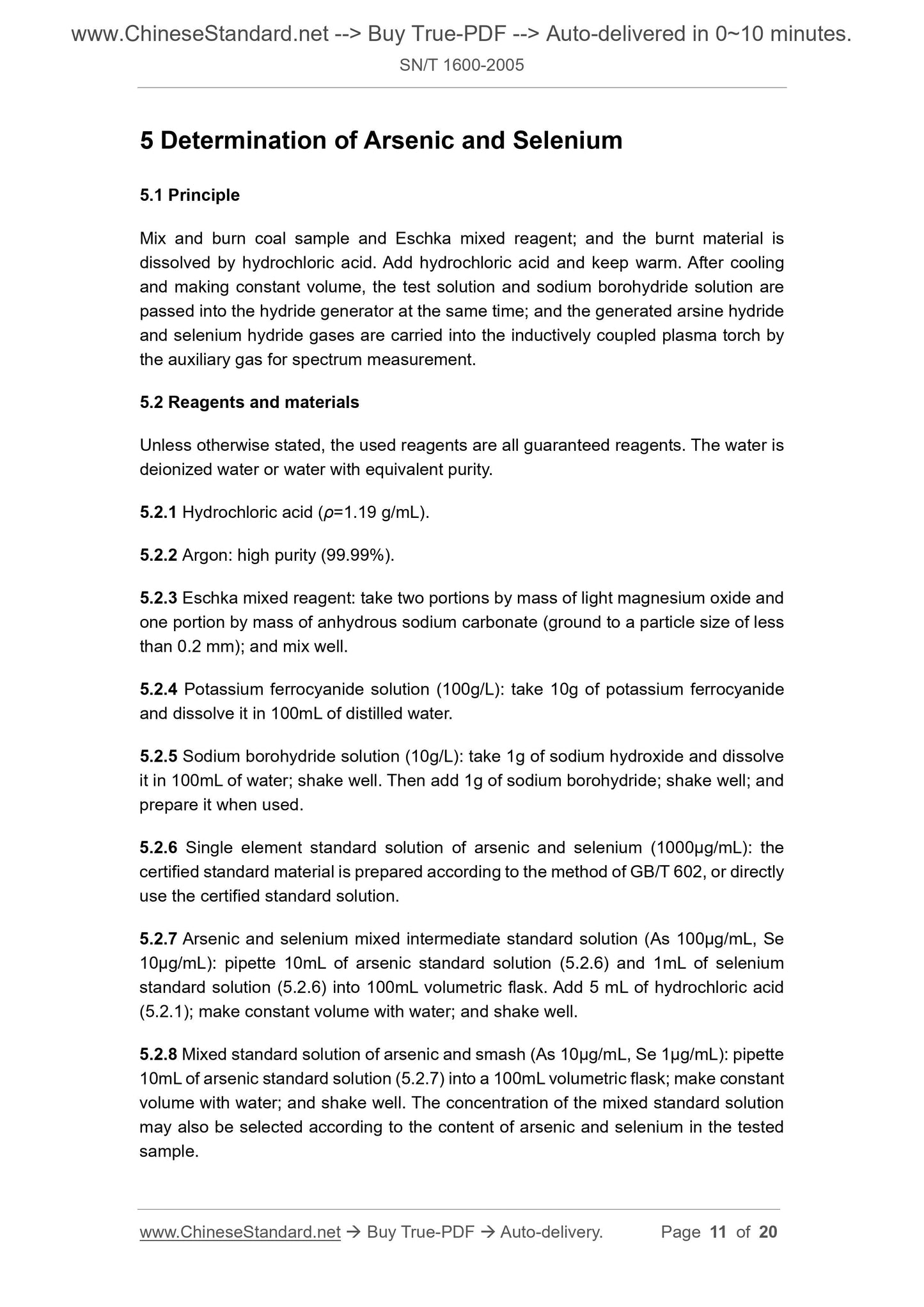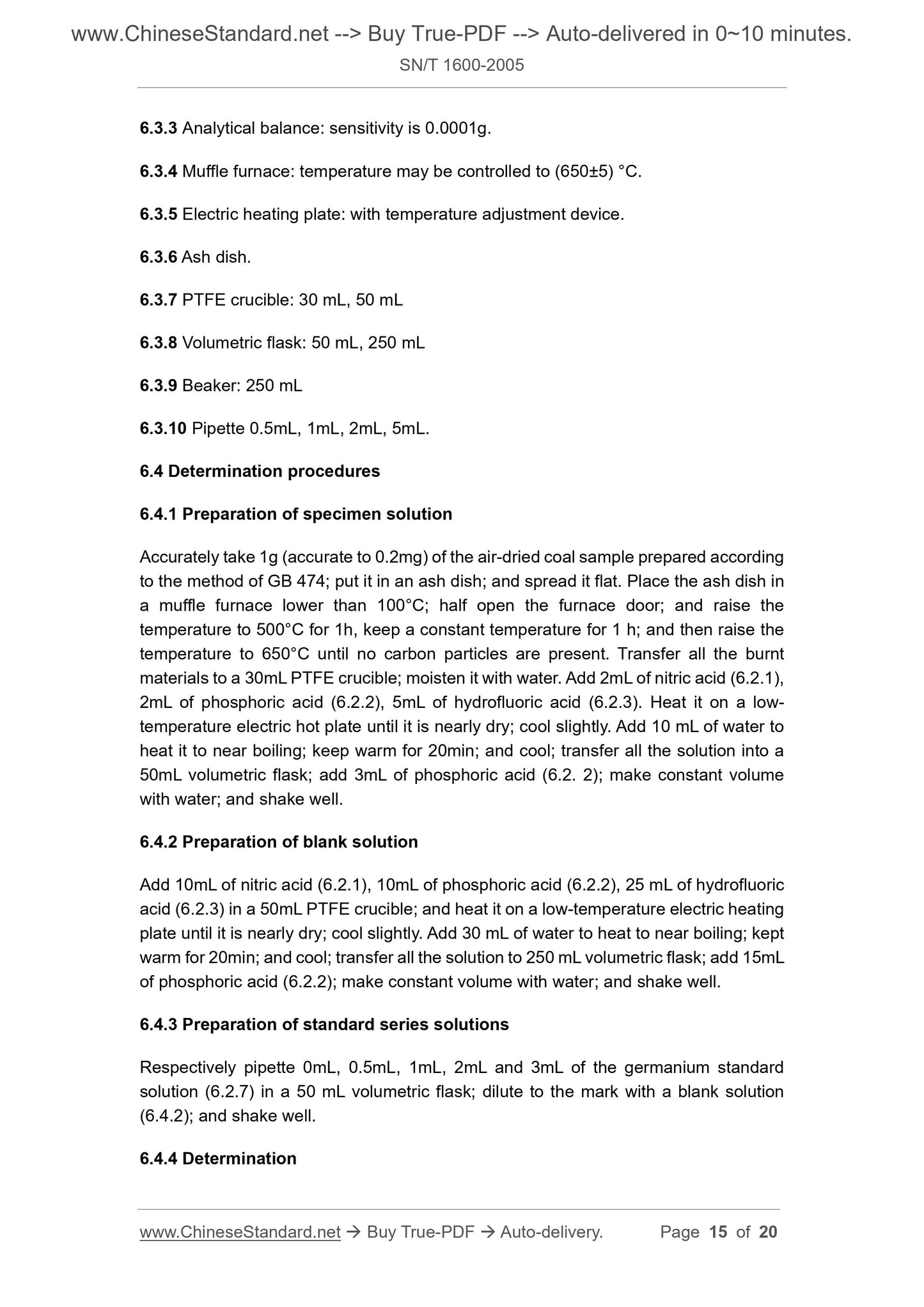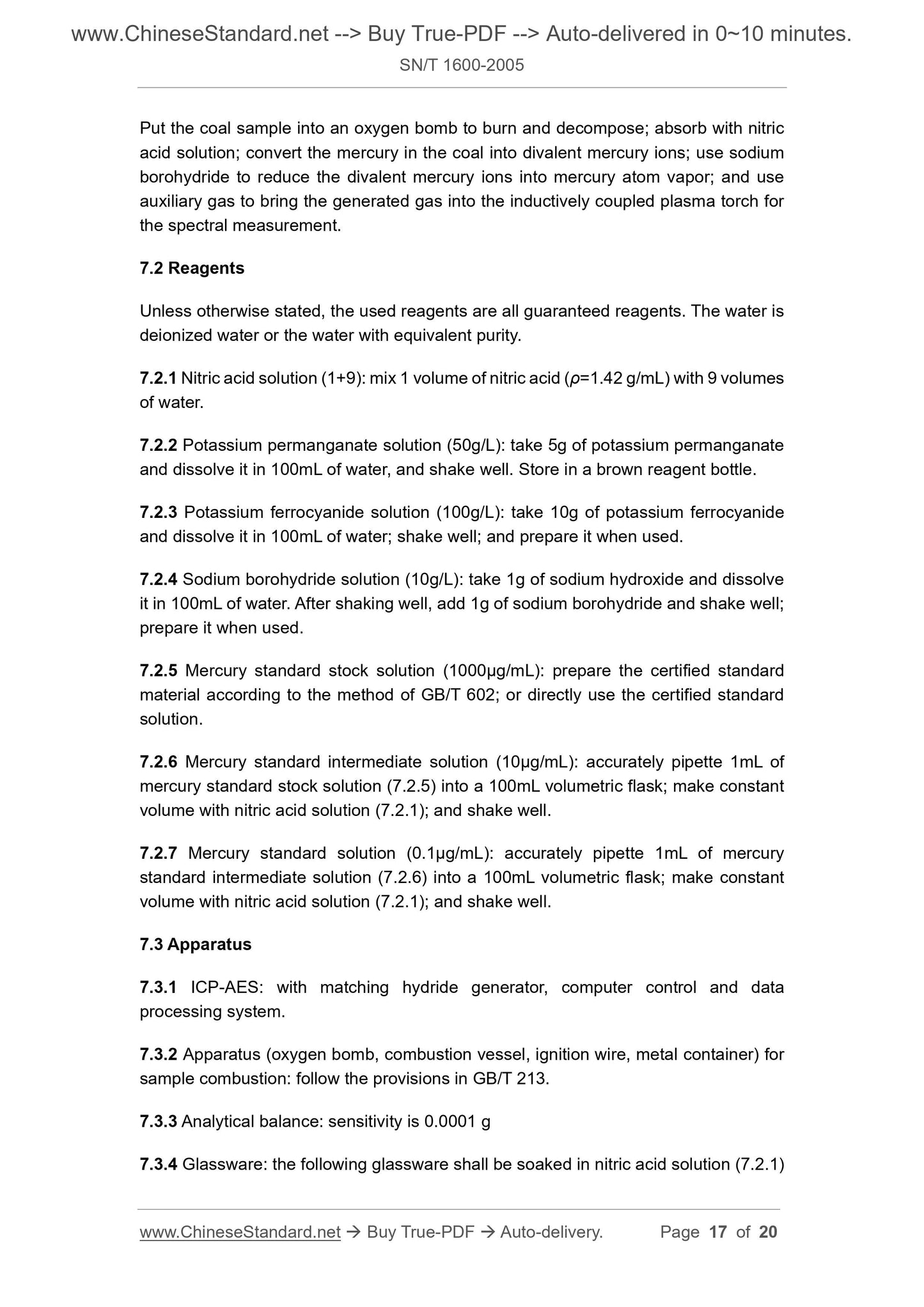1
/
av
8
PayPal, credit cards. Download editable-PDF and invoice in 1 second!
SN/T 1600-2005 English PDF (SNT1600-2005)
SN/T 1600-2005 English PDF (SNT1600-2005)
Ordinarie pris
$200.00 USD
Ordinarie pris
Försäljningspris
$200.00 USD
Enhetspris
/
per
Frakt beräknas i kassan.
Det gick inte att ladda hämtningstillgänglighet
Delivery: 3 seconds. Download true-PDF + Invoice.
Get QUOTATION in 1-minute: Click SN/T 1600-2005
Historical versions: SN/T 1600-2005
Preview True-PDF (Reload/Scroll if blank)
SN/T 1600-2005: Determination for trace elements in coal by ICP-AES
SN/T 1600-2005
SN
ENTRY-EXIT INSPECTIONA AND QUARANTINE INDUSTRY
STANDARD OF THE PEOPLE’S REPUBLIC OF CHINA
Determination for Trace Elements in Coal by ICP-AES
ISSUED ON: MAY 20, 2005
IMPLEMENTED ON: DECEMBER 01, 2005
Issued by: General Administration of Quality Supervision, Inspection and
Quarantine
Table of Contents
Foreword ... 3
1 Scope ... 4
2 Normative References ... 4
3 Determination of Barium, Beryllium, Cadmium, Cobalt, Chromium, Copper,
Gallium, Manganese, Molybdenum, Nickel, Lead, Strontium, Vanadium, Zinc,
Zirconium ... 5
4 Determination of Boron ... 8
5 Determination of Arsenic and Selenium ... 11
6 Determination of Germanium ... 14
7 Determination of Mercury ... 16
Appendix A (Informative) Working Conditions of the Instrument ... 20
Determination for Trace Elements in Coal by ICP-AES
1 Scope
This Standard specifies the inductively coupled plasma atomic emission spectroscopy
(ICP-AES for short) of barium, beryllium, cadmium, cobalt, chromium, copper, gallium,
manganese, molybdenum, nickel, lead, strontium, vanadium, zinc, zirconium, boron,
arsenic, selenium, germanium and mercury in coal.
This Standard is applicable for the determination of barium, beryllium, cadmium, cobalt,
chromium, copper, gallium, manganese, molybdenum, nickel, lead, strontium,
vanadium, zinc, zirconium, boron, arsenic, selenium, germanium and mercury in coal.
Coke may also refer to for use.
The detection limits of 20 elements in this Standard are shown in Table 1.
2 Normative References
The provisions in following documents become the provisions of this Standard through
reference in this Standard. For dated references, the subsequent amendments
(excluding corrigendum) or revisions do not apply to this Standard, however, parties
who reach an agreement based on this Standard are encouraged to study if the latest
versions of these documents are applicable. For undated references, the latest edition
of the referenced document applies.
GB 474 Methods for the Preparation of Coal Sample (eqv ISO 1988)
GB/T 213 Determination of Calorific Value of Coal (ISO 1928, NEQ)
GB/T 602 Chemical Reagent – Preparations of Standard Solutions for Impurity (ISO
6353-1, NEQ)
3.3 Apparatus
3.3.1 ICP-AES: with computer control and data processing system.
3.3.2 Analytical balance: sensitivity is 0.0001g
3.3.3 Electric heating plate: temperature is controllable.
3.3.4 Muffle furnace: the temperature may be controlled to (500±5) °C.
3.3.5 Ash dish: The bottom of the rectangular ash dish is 105mm long, 50mm wide,
and 15mm high.
3.3.6 Volumetric flask: 100mL.
3.3.7 Pipette: 0.5mL, 5mL, 10mL.
3.3.8 PTFE crucible: 50mL.
3.3.9 Plastic bottle: 100mL.
3.4 Test Procedures
3.4.1 Preparation of specimen solution
3.4.1.1 Ashing of coal sample
Accurately take 2g (accurate to 0.2 mg) of the air-dried analytical coal sample prepared
in accordance with the method of GB 474 in a ash dish; flatten it; and place the ash
dish in a muffle furnace below 100°C; and raise the temperature to 300° for 1 h; then
raise the temperature to 500°C for 1 h; and burn at this temperature to no carbon
particles.
3.4.1.2 Decomposition of ash sample
Transfer all the ash samples (3.4.1.1) to a PTFE crucible; moisten it with a little water;
add 5mL of nitric acid (3.2.1), 5mL of perchloric acid (3.2.2) and 15mL of hydrofluoric
acid (3.2.3); heat on a hot plate; heat at 100°C for 2h, heated at 150°C for 2h, heat at
180°C until nearly dry; cool. Add 5 mL of nitric acid (3.2.1) and 15 mL of distilled water;
Heat on the hot plate to slightly boil; and keep it for 20min; dissolve the salts; cool; and
transfer all the solution to a 100 mL volumetric flask; make constant volume with water;
shake well and then transfer to a 100 mL plastic bottle immediately.
3.4.2 Blank test
Except for not weighing the sample, perform with the specimen according to procedure
3.4.1.
4.2.5 Boron standard stock solution (1000µg/mL): prepare standard solution according
to the method of GB/T 602; or directly use certified standard solution.
4.2.6 Boron standard solution (50µm/mL): accurately pipette 5mL of the boron
standard stock solution (4.2.5) into a 100 mL plastic volumetric flask; make constant
volume with water; and shake well.
4.3 Apparatus
4.3.1 ICP-AES: with computer control and data processing system.
4.3.2 Balance: sensitivity is 0.0001g.
4.3.3 Muffle furnace: the temperature may be controlled to (780±5) °C.
4.3.4 Platinum crucible: 30mL.
4.3.5 Plastic volumetric flask: 100mL.
4.3.6 Plastic beaker: 300mL.
4.3.7 Pipette: 1 mL, 10mL.
4.4 Test procedures
4.4.1 Preparation of specimen solution
Accurately weigh 1g (accurate to 0.0001g) of the air-dried analytical coal sample
prepared in accordance with GB 474; and put it into a platinum crucible containing 1.0g
of Eschka mixed reagent (4.2.3); mix carefully; and then cover with 1.0g of Eschka
mixed reagent (4.2.3). Put the crucible into a muffle furnace below 100°C; and raise
the temperature to 500°C for 1 h, keep the temperature constant for 1h; and then raise
the temperature to 780°C, keep the temperature constant for 3h.
Take the platinum crucible out of the muffle furnace and cool it to room temperature.
Transfer the burnt material of the crucible into a 300mL plastic beaker containing 50mL
of water. Carefully clean the inner wall of the crucible with water; pour the rinse solution
into a 300 mL plastic beaker; and add 15 mL of hydrochloric acid (4.2.1); fully dissolve;
the solution in the plastic beaker is filtered into a 100 mL plastic volumetric flask; and
make the constant volume with water; and shake well.
4.4.2 Blank test
Except for not weighing the sample, the others shall be carried out according to the
procedures of 4.4.1.
4.4.3 Preparation of standard series solutions
5 Determination of Arsenic and Selenium
5.1 Principle
Mix and burn coal sample and Eschka mixed reagent; and the burnt material is
dissolved by hydrochloric acid. Add hydrochloric acid and keep warm. After cooling
and making constant volume, the test solution and sodium borohydride solution are
passed into the hydride generator at the same time; and the generated arsine hydride
and selenium hydride gases are carried into the inductively coupled plasma torch by
the auxiliary gas for spectrum measurement.
5.2 Reagents and materials
Unless otherwise stated, the used reagents are all guaranteed reagents. The water is
deionized water or water with equivalent purity.
5.2.1 Hydrochloric acid (ρ=1.19 g/mL).
5.2.2 Argon: high purity (99.99%).
5.2.3 Eschka mixed reagent: take two portions by mass of light magnesium oxide and
one portion by mass of anhydrous sodium carbonate (ground to a particle size of less
than 0.2 mm); and mix well.
5.2.4 Potassium ferrocyanide solution (100g/L): take 10g of potassium ferrocyanide
and dissolve it in 100mL of distilled water.
5.2.5 Sodium borohydride solution (10g/L): take 1g of sodium hydroxide and dissolve
it in 100mL of water; shake well. Then add 1g of sodium borohydride; shake well; and
prepare it when used.
5.2.6 Single element standard solution of arsenic and selenium (1000µg/mL): the
certified standard material is prepared according to the method of GB/T 602, or directly
use the certified standard solution.
5.2.7 Arsenic and selenium mixed intermediate standard solution (As 100µg/mL, Se
10µg/mL): pipette 10mL of arsenic standard solution (5.2.6) and 1mL of se...
Get QUOTATION in 1-minute: Click SN/T 1600-2005
Historical versions: SN/T 1600-2005
Preview True-PDF (Reload/Scroll if blank)
SN/T 1600-2005: Determination for trace elements in coal by ICP-AES
SN/T 1600-2005
SN
ENTRY-EXIT INSPECTIONA AND QUARANTINE INDUSTRY
STANDARD OF THE PEOPLE’S REPUBLIC OF CHINA
Determination for Trace Elements in Coal by ICP-AES
ISSUED ON: MAY 20, 2005
IMPLEMENTED ON: DECEMBER 01, 2005
Issued by: General Administration of Quality Supervision, Inspection and
Quarantine
Table of Contents
Foreword ... 3
1 Scope ... 4
2 Normative References ... 4
3 Determination of Barium, Beryllium, Cadmium, Cobalt, Chromium, Copper,
Gallium, Manganese, Molybdenum, Nickel, Lead, Strontium, Vanadium, Zinc,
Zirconium ... 5
4 Determination of Boron ... 8
5 Determination of Arsenic and Selenium ... 11
6 Determination of Germanium ... 14
7 Determination of Mercury ... 16
Appendix A (Informative) Working Conditions of the Instrument ... 20
Determination for Trace Elements in Coal by ICP-AES
1 Scope
This Standard specifies the inductively coupled plasma atomic emission spectroscopy
(ICP-AES for short) of barium, beryllium, cadmium, cobalt, chromium, copper, gallium,
manganese, molybdenum, nickel, lead, strontium, vanadium, zinc, zirconium, boron,
arsenic, selenium, germanium and mercury in coal.
This Standard is applicable for the determination of barium, beryllium, cadmium, cobalt,
chromium, copper, gallium, manganese, molybdenum, nickel, lead, strontium,
vanadium, zinc, zirconium, boron, arsenic, selenium, germanium and mercury in coal.
Coke may also refer to for use.
The detection limits of 20 elements in this Standard are shown in Table 1.
2 Normative References
The provisions in following documents become the provisions of this Standard through
reference in this Standard. For dated references, the subsequent amendments
(excluding corrigendum) or revisions do not apply to this Standard, however, parties
who reach an agreement based on this Standard are encouraged to study if the latest
versions of these documents are applicable. For undated references, the latest edition
of the referenced document applies.
GB 474 Methods for the Preparation of Coal Sample (eqv ISO 1988)
GB/T 213 Determination of Calorific Value of Coal (ISO 1928, NEQ)
GB/T 602 Chemical Reagent – Preparations of Standard Solutions for Impurity (ISO
6353-1, NEQ)
3.3 Apparatus
3.3.1 ICP-AES: with computer control and data processing system.
3.3.2 Analytical balance: sensitivity is 0.0001g
3.3.3 Electric heating plate: temperature is controllable.
3.3.4 Muffle furnace: the temperature may be controlled to (500±5) °C.
3.3.5 Ash dish: The bottom of the rectangular ash dish is 105mm long, 50mm wide,
and 15mm high.
3.3.6 Volumetric flask: 100mL.
3.3.7 Pipette: 0.5mL, 5mL, 10mL.
3.3.8 PTFE crucible: 50mL.
3.3.9 Plastic bottle: 100mL.
3.4 Test Procedures
3.4.1 Preparation of specimen solution
3.4.1.1 Ashing of coal sample
Accurately take 2g (accurate to 0.2 mg) of the air-dried analytical coal sample prepared
in accordance with the method of GB 474 in a ash dish; flatten it; and place the ash
dish in a muffle furnace below 100°C; and raise the temperature to 300° for 1 h; then
raise the temperature to 500°C for 1 h; and burn at this temperature to no carbon
particles.
3.4.1.2 Decomposition of ash sample
Transfer all the ash samples (3.4.1.1) to a PTFE crucible; moisten it with a little water;
add 5mL of nitric acid (3.2.1), 5mL of perchloric acid (3.2.2) and 15mL of hydrofluoric
acid (3.2.3); heat on a hot plate; heat at 100°C for 2h, heated at 150°C for 2h, heat at
180°C until nearly dry; cool. Add 5 mL of nitric acid (3.2.1) and 15 mL of distilled water;
Heat on the hot plate to slightly boil; and keep it for 20min; dissolve the salts; cool; and
transfer all the solution to a 100 mL volumetric flask; make constant volume with water;
shake well and then transfer to a 100 mL plastic bottle immediately.
3.4.2 Blank test
Except for not weighing the sample, perform with the specimen according to procedure
3.4.1.
4.2.5 Boron standard stock solution (1000µg/mL): prepare standard solution according
to the method of GB/T 602; or directly use certified standard solution.
4.2.6 Boron standard solution (50µm/mL): accurately pipette 5mL of the boron
standard stock solution (4.2.5) into a 100 mL plastic volumetric flask; make constant
volume with water; and shake well.
4.3 Apparatus
4.3.1 ICP-AES: with computer control and data processing system.
4.3.2 Balance: sensitivity is 0.0001g.
4.3.3 Muffle furnace: the temperature may be controlled to (780±5) °C.
4.3.4 Platinum crucible: 30mL.
4.3.5 Plastic volumetric flask: 100mL.
4.3.6 Plastic beaker: 300mL.
4.3.7 Pipette: 1 mL, 10mL.
4.4 Test procedures
4.4.1 Preparation of specimen solution
Accurately weigh 1g (accurate to 0.0001g) of the air-dried analytical coal sample
prepared in accordance with GB 474; and put it into a platinum crucible containing 1.0g
of Eschka mixed reagent (4.2.3); mix carefully; and then cover with 1.0g of Eschka
mixed reagent (4.2.3). Put the crucible into a muffle furnace below 100°C; and raise
the temperature to 500°C for 1 h, keep the temperature constant for 1h; and then raise
the temperature to 780°C, keep the temperature constant for 3h.
Take the platinum crucible out of the muffle furnace and cool it to room temperature.
Transfer the burnt material of the crucible into a 300mL plastic beaker containing 50mL
of water. Carefully clean the inner wall of the crucible with water; pour the rinse solution
into a 300 mL plastic beaker; and add 15 mL of hydrochloric acid (4.2.1); fully dissolve;
the solution in the plastic beaker is filtered into a 100 mL plastic volumetric flask; and
make the constant volume with water; and shake well.
4.4.2 Blank test
Except for not weighing the sample, the others shall be carried out according to the
procedures of 4.4.1.
4.4.3 Preparation of standard series solutions
5 Determination of Arsenic and Selenium
5.1 Principle
Mix and burn coal sample and Eschka mixed reagent; and the burnt material is
dissolved by hydrochloric acid. Add hydrochloric acid and keep warm. After cooling
and making constant volume, the test solution and sodium borohydride solution are
passed into the hydride generator at the same time; and the generated arsine hydride
and selenium hydride gases are carried into the inductively coupled plasma torch by
the auxiliary gas for spectrum measurement.
5.2 Reagents and materials
Unless otherwise stated, the used reagents are all guaranteed reagents. The water is
deionized water or water with equivalent purity.
5.2.1 Hydrochloric acid (ρ=1.19 g/mL).
5.2.2 Argon: high purity (99.99%).
5.2.3 Eschka mixed reagent: take two portions by mass of light magnesium oxide and
one portion by mass of anhydrous sodium carbonate (ground to a particle size of less
than 0.2 mm); and mix well.
5.2.4 Potassium ferrocyanide solution (100g/L): take 10g of potassium ferrocyanide
and dissolve it in 100mL of distilled water.
5.2.5 Sodium borohydride solution (10g/L): take 1g of sodium hydroxide and dissolve
it in 100mL of water; shake well. Then add 1g of sodium borohydride; shake well; and
prepare it when used.
5.2.6 Single element standard solution of arsenic and selenium (1000µg/mL): the
certified standard material is prepared according to the method of GB/T 602, or directly
use the certified standard solution.
5.2.7 Arsenic and selenium mixed intermediate standard solution (As 100µg/mL, Se
10µg/mL): pipette 10mL of arsenic standard solution (5.2.6) and 1mL of se...
Share
